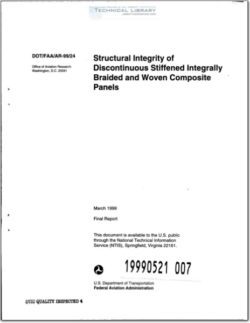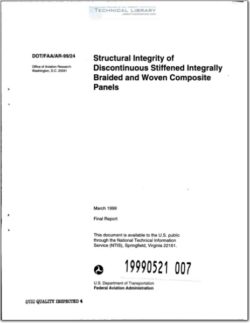DOT-FAA-AR-99-24

- Version
- 185 Downloads
- 2.08 MB File Size
- 1 File Count
- March 24, 2016 Create Date
- March 24, 2016 Last Updated
Structural Integrity of Discontinuous Stiffened Integrally Braided and Woven Composite Panels

Textile preform composites offer cost, processing, and performance advantages compared to
conventional laminated composites. Hence, textile composites are attractive candidates for
construction of the stiffened panels widely used in airframe structures. In such applications, the
stiffener discontinuity induces high levels of interlaminar stresses. When the stiffened panels are
fabricated from conventional laminated composite materials, stresses at the stiffener terminations
lead to premature failure of the panels. The superior strength and damage tolerance of the
integrally braided and woven textile preform composites are likely to be assets in such situations.
The objective of this study was to evaluate the structural integrity of discontinuous blade—
stiffened panels made of textile preform composites and to compare their strength and failure
modes with those of conventional laminated stiffened panels. Three-dimensional (3D) braided
(0°/i17°) and 3D orthogonal woven (0°/90°/90°) composite panels made of BASF G30-500
graphite fiber yarns and Dow Chemical’s Tactix-123 matrix were evaluated. Resin transfer
molding was used for fabricating the stiffened panels. Specimens were fabricated and tested
under quasi-static tension and tension-tension fatigue.
Five braided composite panels and five woven composite panels were tested under quasi-static
tension to identify failure initiation, failure modes, and final fracture. These specimens were
instrumented with strain gages and the strains were continuously monitored during the tests. The
maximum peel and shear stresses at the notch root were about 40% and 80% of the axial stress
and they caused failure initiation. In braided composite specimens, failure was initiated by peel
stresses and in woven specimens by shear stresses leading to stiffener separation or disbond.
Final fracture of both braided and woven composite panels were by net section tensile failure.
The average strengths at final failure of the braided and the woven panels were 433.7 MPa and
581.8 MPa, respectively. However, the initial failure of the woven panels was stiffener
separation but because the load carried by the blade stiffener was only about 10% of the total
load, the panels were able to carry additional load in the skin of the panel until final failure
occurred in tension. The stiffener separation occurred at about 28% of the final failure load
(1627 MPa). This load level is considered as the usefiJl capability of the panel. Thus the
behavior of the woven panels were similar to the conventional tape construction while the
braided panel avoided the stiffener separation failure mode.
| File | Action |
|---|---|
| DOT-FAA-AR-99-24 Structural Integrity of Discontinuous Stiffened Integrally Braided and Woven Composite Panels.pdf | Download |

Comment On This Post